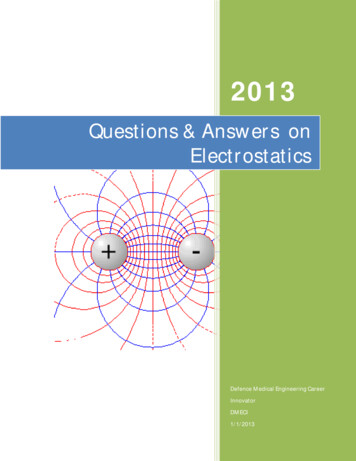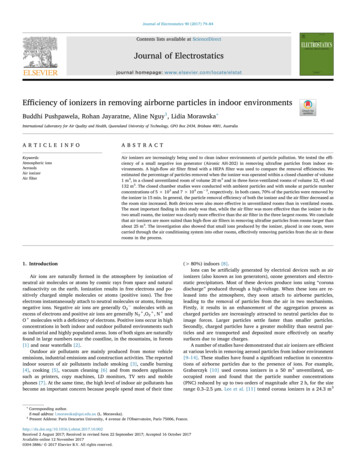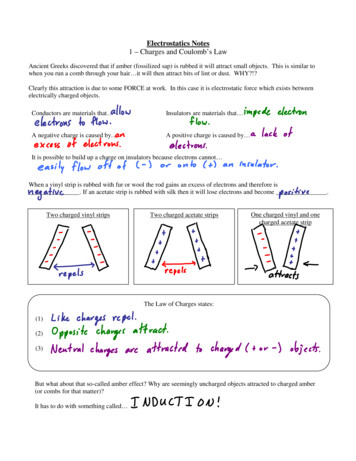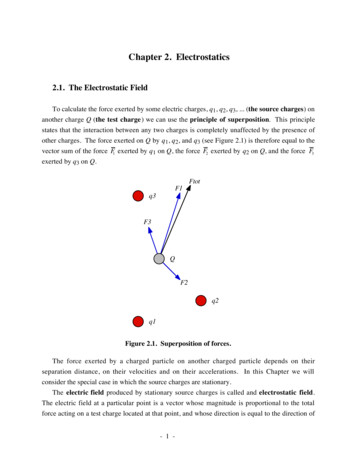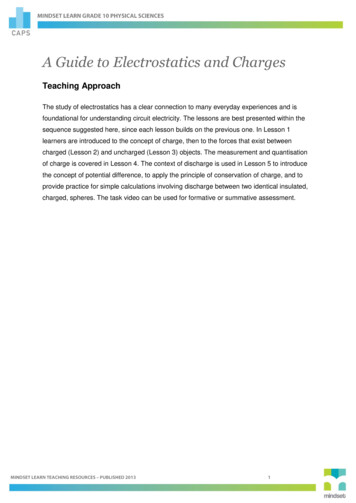
Transcription
A Guide to Electrostatics and ChargesTeaching ApproachThe study of electrostatics has a clear connection to many everyday experiences and isfoundational for understanding circuit electricity. The lessons are best presented within thesequence suggested here, since each lesson builds on the previous one. In Lesson 1learners are introduced to the concept of charge, then to the forces that exist betweencharged (Lesson 2) and uncharged (Lesson 3) objects. The measurement and quantisationof charge is covered in Lesson 4. The context of discharge is used in Lesson 5 to introducethe concept of potential difference, to apply the principle of conservation of charge, and toprovide practice for simple calculations involving discharge between two identical insulated,charged, spheres. The task video can be used for formative or summative assessment.
Video SummariesSome videos have a ‘PAUSE’ moment, at which point the teacher or learner can choose topause the video and try to answer the question posed or calculate the answer to the problemunder discussion. Once the video starts again, the answer to the question or the right answerto the calculation is givenMindset suggests a number of ways to use the video lessons. These include: Watch or show a lesson as an introduction to a lesson Watch or show a lesson after a lesson, as a summary or as a way of adding in someinteresting real-life applications or practical aspects Design a worksheet or set of questions about one video lesson. Then ask learners towatch a video related to the lesson and to complete the worksheet or questions, either ingroups or individually Worksheets and questions based on video lessons can be used as short assessments orexercises Ask learners to watch a particular video lesson for homework (in the school library or onthe website, depending on how the material is available) as preparation for the next dayslesson; if desired, learners can be given specific questions to answer in preparation forthe next day’s lesson1. ChargeLearners are given a brief history of the development of the concept of charge, introducedto the various scientific meanings of charge, and shown how insulators can be charged.2. Electrostatic ForceThe hypothesis that like charges repel and opposite charges attract is confirmed in thislesson.3. PolarisationPolarisation is demonstrated and explained with the aid of practical examples.4. Charge QuantisationThe principle of quantisation of charge is explained and the coulomb is introduced as theunit for measuring charge.5. Charge ConservationThe principle of conservation of charge is stated. Electrical discharge is explained anddemonstrated. The learners are also led through worked examples of calculations of thecharge on two insulated metal spheres.
Resource Material1. Charge2. Electrostatic Forces3. Polarisation4. Charge Quantisation5. Charge charge-29575756A Slideshare presentation with mostof the visuals used in this oltageA PhET simulation: John Travoltage.Charge John by rubbing his footagainst the carpet. Discharge him bymoving his hand towards estatics/The Physics Classroom contentspage for electrostatics. Containsmany links to very useful resourcesfor the entire trostatic-forces-29591362A Slideshare presentation containingsome of the visuals used in electric-hockeyA PhET simulation: Electric ence/grade-10/electrostaticsInteractive quizzes for the entireelectrostatics loonsA PhET simulation: Balloons andstatic polarisation-29597252A Slideshare presentation containingsome of the visuals used in ischarge-29612377A Slideshare presentation containingmost of the visuals used in yavula Grade 10 textbook:Quantisation of charge plusSiyavula Grade 10 textbook:Conservation of nd-fields/electric-chargeVideos about charge and chargecalculations: From Socratic Physics.
TaskQuestion 1Object A is positively charged and object B is negatively charged.AB 1.1 True or false. Correct if false.a) Object A must contain more positive charges than object B.b) Object B must contain more electrons than protons.1.2 Would A and B: [attract / repel / neither attract nor repel] one another?1.3 Explain how B may have become negatively charged.1.4 Explain what happens when a spark forms between A and B.1.5 Object A attracts object C. Object B repels object C. What is the charge on object C?AC attract CB repel1.6 Object A attracts object D. Object B attracts object D. Explain why this can be so.A DD attractB attract1.7 Object A repels object E. Would Object B attract E or repel it?A EBrepelEQuestion 2Object A is negatively charged. Object B is positively charged. Object C’s charge isunknown.- AB?C
Object A attracts object C. This means that either object C is charged or that it can bepolarized. Explain a further test that could be done to find out whether C is charged orneutral.Give your answer in this form:[Give instructions on what to do]. If [describe what might be observed], then you know that Cis charged. If [describe what might be observed], then you know that C is neutral.Question 3Two identical spheres are on insulated stands. One has a charge of 3 C and the other of 2C. The two spheres are moved close enough together so that discharge can occur.3.1 Which way will electrons move (from 3 C to 2C or from 2 C to 3C or neither)3.2 Explain your answer to 3.1.3.3 Will the sphere which loses electrons in discharge become more, or less, positive?3.4 Will discharge neutralise the two spheres? (yes/no)3.5 What will the final charge on each sphere be?Question 4The charge on one electron is -1,6 x 10-19 C.4.1 State the principle of quantisation of charge.4.2 What is the charge of an object which has 1 million (1x106) fewer electrons thanprotons?4.3 Are these charges possible?a) 155 x (-1,6x10-19 C)b) 15,5 x (-1,6x10-19 C)c) 6 x 1019 x ( 1,6x10-19 C)d) 15,5 CQuestion 5Read the description for the following investigation. Then answer the questions related to it:Two pieces of Sellotape are placed next to one another. They neither attract nor repel.a) They are stuck onto a desk and pulled off. Now they repel one another.b) One is stuck onto a desk and the other stuck on top of this one. They are pulled offthe desk and apart. Now they attract one another.What observation suggests that:5.1 Pulling the Sellotape strips off surfaces charged them.5.2 There are two types of charge.5.3 Like charges repel.5.4 In b) the pieces of Sellotape must have become charged oppositely to one another.
Task AnswersQuestion 11.11.21.31.41.51.61.7a) False. A has more positive charges than A has negative charges, but not necessarily morepositive charges than B.b) TrueAttractElectrons were transferred to B, e.g when B is rubbed.Electrons move from B to A in a discharge which removes the potential difference and differencein charged state between A and B.NegativeObject D is polarised by the presence of either charged object. This means that the chargedistribution in D is distorted by the presence of the charged object, such that charges opposite tothe charged object are attracted to the side closest to that object, causing attraction. [Since theattractive force between the charged object and the nearer opposite charge is greater than therepulsive force between the charged object and the further like charge, the two attract oneanother].attractQuestion 2Bring a positively charged object closer to C, if it is repelled, you know that C is charged. If it isattracted, you know C is neutral.Question 33.1 From 2 C to 3C3.2 The 2 C object is less positive, and therefore more negative, than the 3 C object and electronswill move from the more negatively charged object.3.3 More positive.3.4 No3.5 Final charge 2,5 CQuestion 44.1 It is not possible for an object to have a charge which is not a whole number of the electron’scharge6-19-134.2 1 x 10 x ( 1,6 x10 ) C 1,6 x 10 C4.3a) Yesb) Yesc) Nod) YesQuestion 55.1 Before they didn’t apply a force on one another. Afterwards they did.5.2 There are two types of interaction (attraction and repulsion) so there must be two types ofcharge.5.3 The pieces that were treated identically must be like charged, and they repelled.5.4 These pieces behaved differently to those which were known to be of like charge, they must becharged unlike to one another.
AcknowledgementsMindset Learn Executive HeadContent Manager Classroom ResourcesContent Coordinator Classroom ResourcesContent AdministratorContent DeveloperContent ReviewersDylan BusaJenny LamontHelen RobertsonAgness MunthaliAngela StottLiz HarrisRoss MooreDuncan ChirigaProduced for Mindset Learn by TrafficFacilities CoordinatorProduction ManagerDirectorEditorPresenterStudio CrewGraphicsCezanne ScheepersBelinda RenneyAlriette GibbsNonhlanhla NxumaloNiki MontgomeryAbram TjaleJames TselapediWilson MthembuWayne SandersonCreditsThis resource is licensed under a Attribution-Share Alike 2.5 South Africa licence. When usingthis resource please attribute Mindset as indicated at http://www.mindset.co.za/creativecommons
foundational for understanding circuit electricity. The lessons are best presented within the sequence suggested here, since each lesson builds on the previous one. In Lesson 1 learners are introduced to the concept of charge, then to the forces that exist between charged (Lesson 2) and uncharged (Lesson 3) objects. The measurement and quantisation
